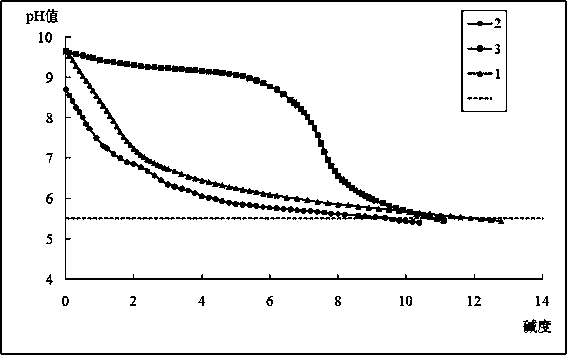Engine coolant and preparation method thereof
An engine coolant and solution technology, applied in chemical instruments and methods, heat exchange materials, etc., can solve the problems of difficult to protect metal iron, low buffer platform, etc., to achieve the effect of small corrosion and improved protection
- Summary
- Abstract
- Description
- Claims
- Application Information
AI Technical Summary
Problems solved by technology
Method used
Image
Examples
preparation example Construction
[0025] The invention provides a preparation method of the engine coolant, comprising the following steps:
[0026] a. Dissolve fatty acids or fatty acid salts, aromatic acids or aromatic acid salts and additives in water, adjust the pH value to 9.0-10.5, and record it as solution A;
[0027] b. Dissolve the silicate in water to form a silicate solution; add the silicate solution into solution A, stir evenly, and record it as solution B;
[0028] c. Filter solution B, add ethylene glycol to the filtrate, and stir evenly to obtain the engine coolant.
[0029] According to the preparation method provided by the present invention, fatty acids or fatty acid salts, aromatic acids or aromatic acid salts and additives are dissolved in part of the water, and the pH value is adjusted to 9.0-10.5, which is recorded as solution A; in addition, the remaining silicate solution Prepare a silicate solution in water, and then pour it into A. In order to avoid precipitation when the silicate s...
Embodiment 1
[0032] (1) Add 470 parts by weight of deionized water to the container, then add 5 parts by weight of borax, 15 parts by weight of 2-aminoglutaric acid, 5 parts by weight of succinic acid, 5 parts by weight of sebacic acid, and 5 parts by weight of sodium benzoate , 5 parts by weight of terephthalic acid, 5 parts by weight of p-nitrobenzoic acid, 1 part by weight of benzotriazole, 25 parts by weight of sodium hydroxide, stirred to dissolve; finally add silicate stabilizer modified siloxane N4144 ( The molecular formula is CH 3 O(CH 2 CH 3 O) 7.8 C 3 h 6 Si(OCH 3 ) 3 ) 0.3 parts by weight, and stirred evenly to obtain solution A1.
[0033] (2) In another container, add 75 parts by weight of deionized water, then add 1 part by weight of sodium silicate nonahydrate and stir until dissolved to prepare a sodium silicate solution; add the sodium silicate solution to solution A1, stir evenly, and obtain Solution B1.
[0034] (3) Filter solution B1, add 380 parts by weight of e...
Embodiment 2
[0041] (1) Add 450 parts by weight of deionized water into the container, then add 20 parts by weight of 2-aminoglutaric acid, 5 parts by weight of glutaric acid, 7 parts by weight of capric acid, 5 parts by weight of terephthalic acid, and 5 parts by weight of sodium benzoate Parts by weight, 3 parts by weight of isooctanoic acid, 1 part by weight of benzotriazole, and 27 parts by weight of sodium hydroxide were stirred until dissolved; finally, 0.3 parts by weight of silicate stabilizer sodium aluminate was added and stirred evenly to obtain solution A2.
[0042] (2) Quantitatively add 75 parts by weight of deionized water into another container, then add 0.5 parts by weight of sodium silicate nonahydrate and stir until dissolved to prepare a sodium silicate solution; add the sodium silicate solution to solution A2, stir evenly, Solution B2 is obtained.
[0043] (3) Filter solution B2, add 190 parts by weight of ethylene glycol, 5 ppm sodium fluorescein and 50 ppm silicone d...
PUM
 Login to View More
Login to View More Abstract
Description
Claims
Application Information
 Login to View More
Login to View More - R&D
- Intellectual Property
- Life Sciences
- Materials
- Tech Scout
- Unparalleled Data Quality
- Higher Quality Content
- 60% Fewer Hallucinations
Browse by: Latest US Patents, China's latest patents, Technical Efficacy Thesaurus, Application Domain, Technology Topic, Popular Technical Reports.
© 2025 PatSnap. All rights reserved.Legal|Privacy policy|Modern Slavery Act Transparency Statement|Sitemap|About US| Contact US: help@patsnap.com

